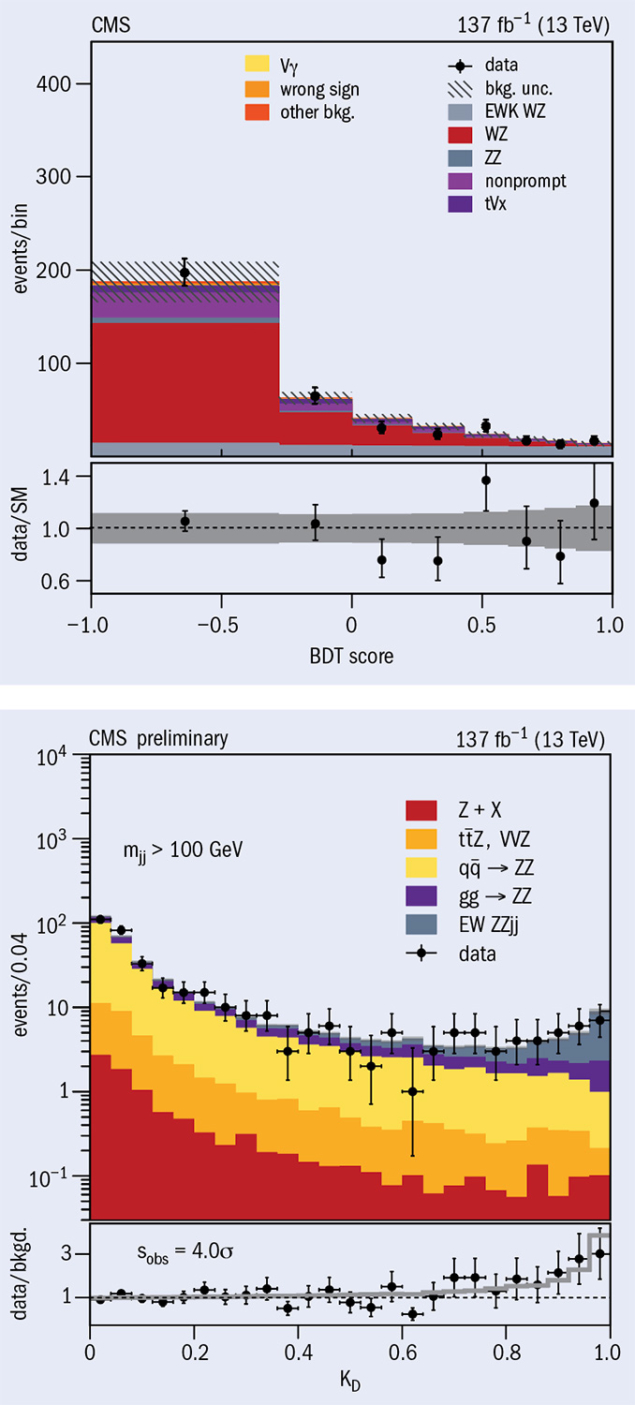A report from the CMS experiment

The electroweak (EW) sector of the Standard Model (SM) predicts self-interactions between W and Z gauge bosons through triple and quartic gauge couplings. Following first measurements at LEP and at the Tevatron during the 1990s, these interactions are now a core part of the LHC physics programme, as they offer key insights into EW symmetry breaking, which, in the case of the SM, causes the W and Z bosons to acquire mass as a result of the Brout–Englert–Higgs mechanism. The quartic coupling can be probed at colliders via rare processes such as tri-boson production, which the CMS collaboration observed for the first time earlier this year, and vector-boson scattering (VBS).
The scattering of longitudinally polarised W and Z bosons is a particularly interesting probe of the SM, as its tree-level amplitudes would violate unitarity at high energies without delicate cancellations from quartic gauge couplings and Higgs-boson contributions. Thus, the study of VBS processes provides key insight into the quartic gauge couplings as well as the Higgs sector. These processes offer sensitivity to enhancements caused by models of physics beyond the SM, which modify the Higgs sector with additional Higgs bosons contributing to VBS.
Vector-boson scattering is characterised by the presence of two forward jets, with a large di-jet invariant mass and a large rapidity separation. CMS previously reported the first observation of same-sign W±W± production using the data collected in 2016. The same-sign W±W± process is chosen because of the smaller background yield from other SM processes compared to the opposite-sign W±W∓ process. The collaboration has now updated this analysis and performed new studies of the EW production of two jets produced in association with WZ, and ZZ boson pairs using data collected between 2016 and 2018 at a centre-of-mass energy of 13 TeV, corresponding to 137 fb–1. Vector-boson pairs were selected by their decays to electrons and muons. The W±W± and WZ production modes were studied by simultaneously measuring their production cross sections using several kinematical observables. The measured total cross section for W±W± production of 3.98 ± 0.45 (± 0.37 stat. only) fb is the most accurate to date, with a precision of roughly 10%. No deviation from SM predictions is evident.
Though the contribution from background processes induced by the strong interaction is considerably larger in the WZ and ZZ final states, the scattering centre-of-mass energy and the polarisation of the final-state bosons can be measured as these final states can be more fully reconstructed than in W±W± production. To optimally isolate signal from background, the kinematical information of the WZ and ZZ candidate events is exploited with a boosted decision tree and matrix element likelihood techniques, respectively (see figure). The observed statistical significances for the WZ and ZZ processes are 6.8 and 4.0 standard deviations, respectively, in line with the expected SM significances of 5.3 and 3.5 standard deviations. The possible presence of anomalous quartic gauge couplings could result in an excess of events with respect to the SM predictions. Strong new constraints on the structure of quartic gauge couplings have been set within the framework of dimension-eight effective-field-theory operators.
The observation of the EW production of W±W±, WZ and ZZ boson pairs is an essential milestone towards precision tests of VBS at the LHC, and there is much more to be learned from the future LHC Run-3 data. The High-Luminosity LHC should allow for very precise investigations of VBS, including finding evidence for the scattering of longitudinally polarised W bosons.
Further reading
CMS Collab. 2020 arXiv:2005.01173.
CMS Collab. 2020 CMS-PAS-SMP-20-001.
CMS Collab. 2020 CMS-PAS-SMP-19-014.








